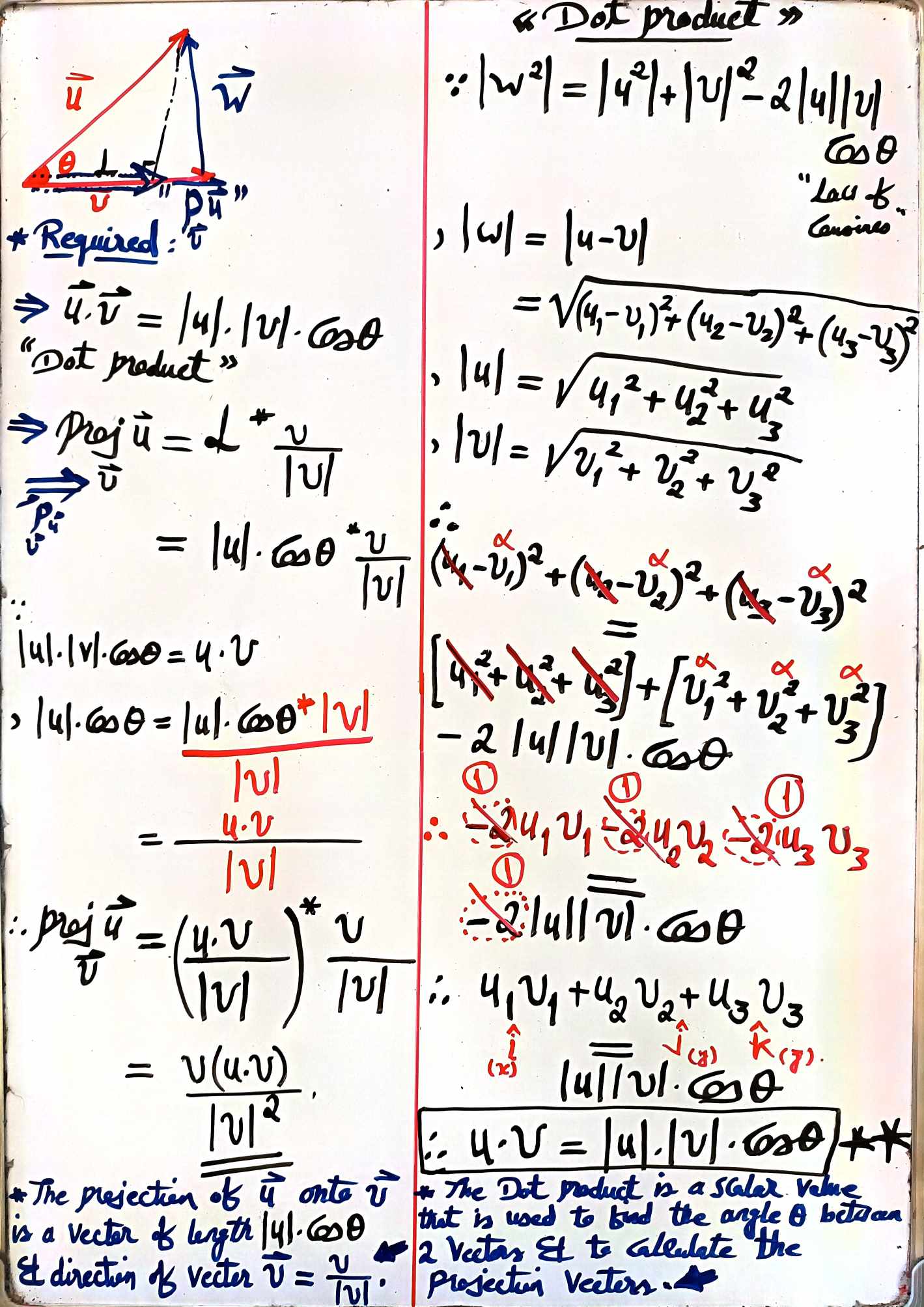Calculus I: Appendix-E: Derivation of the dot product and the projection vectors

1) The dot product:
-
Recall, 2 intersecting vectors $u$ and $v$ together with the resultant vetcor $w$; such that, \(w = u - v\)
-
From the “Law of Cosines”:
- By back-substitution in $Lemma.01$:
- And, by definition $({u_x}{v_x} + {u_y}{v_y} + {u_z}{v_z})$ yields $u.v$, the dot product or the inner product.
2) Projection vectors:
-
Definition: The projection vector $\vec{proj_{\vec{v}}} \vec{u}$ of a vector $\vec{u}$, is the vector component of that vector, that is coincident to the projectile vector $\vec{v}$, multiplied by the unit vector of the projectile vector (i.e., the direction).
-
For a productive proof, let vector $\vec{u}$ be our target vector, the one we would like to find its vector components in the direction of another contigous vectors, and vector $\vec{v}$ be the projectile (aka. base) vector the one we would like to utilize its direction to find the projection vector.
| 1) Finding the norm of the vector component $ | \vec{u_x} | $ that is coincident to the projectile vector $\vec{v}$: |
| 2) Finding the vector norm $ | \vec{v} | $ of the projectile vector $\vec{v}$: |
| 3) Finding the normalization ratio using the scalar division property $\vec{v_{unit}}=\vec{v}/ | \vec{v} | $ of the projectile vector (base vector). |
| 4) Using the scalar multiplication property $ | \vec{u_x} | *\vec{v_{unit}}$: |
\[||\vec{u_x}||*\vec{v_{unit}}=(||\vec{u}||*cos(\theta))\*\vec{v_{unit}}\] \[Since,\vec{u}.\vec{v}=||\vec{u}||*||\vec{v}||\*cos(\theta)\]$Lemma.01$
\[Then,||\vec{u}||*cos(\theta)=(\vec{u}.\vec{v})/||\vec{v}||\]$Lemma.02$
5) Then, from $Lemma.01$ and $Lemma.02$, we can deduce the projection vector formula in terms of the dot product between 2 vectors as follows:
\[\vec{proj_{\vec{v}}}\vec{u}=[({\vec{u}}.{\vec{v}})*{\vec{v_{unit}}}]/||\vec{v}||\]6) Another formula when $\vec{v_{unit}}$ is broken:
\[\vec{proj_{\vec{v}}}\vec{u}=[\vec{u}.\vec{v}*\vec{v}]/||\vec{v}||^2\]Note:
- This is could be applied to other components of vector $\vec{u}$, the $\vec{u_y}$, and the $\vec{u_z}$, and any vector could be utilized as the base or the projectile vector.
- The projection vector of vector $\vec{u}$ on itself $\vec{proj_{\vec{u}}} \vec{u}$ is the vector $\vec{u}$ itself scaled with the length of one of its vector components.
3) Usages Review:
1) Finding the work done by a force vector $(F)$ to move an object a displacement $(D)$ with an inscribed angle $(a)$, formula (Physics):
\[W = F.D = ||F|| * ||D|| * cos(a) = \sum_{i=0}^{n} u_i v_i = u_0 v_0+u_1 v_1+u_2 v_2+...+ u_{n-1} v_{n-1} + u_n v_n\]2) Finding the inscribed angle (<a) between 2 intersecting vectors, formula:
\[m(a) = acos(u.v/(||u|| * ||v||))\]where u.v can be evaluated using the Riemann’s sum formula (Trigo./Physics).
| 3) Finding whether 2 intersecting vectors are orthogonal, formula: $u.v = | u | * | v | * cos(PI/2) = ZERO.$ (Geometry). |
4) Finding projection vectors, formula: “the vector projection of $u$ onto $v$”, formula:
\[proj_{v}^{u} = (||u|| * cos(a)) * (v/||v||) = (u.v / ||v||^2) * v\]
where $( u * cos(a))$ is the length of the triangle base, and $(v/ v )$ is the unit vector form (normalized) of $v$.
5) Finding the total electromotive force (EMF) in a closed circuit loop, formula (aka. Ohm’s Law):
\[V = I * R * cos(0)\]6) Finding the driving arterial blood pressure in a closed arterial circuitry, formula (Hemodynamics):
\[BP = CO * SVR * cos(0)\]References:
- Thomas’ Calculus $14^{th}e$: Ch.12 Vectors & Geometry of Space: Section.12.3. (The Dot Product).
- Guyton and Hall Textbook of Medical Physiology $13^{th}e$
- Applied Linear Algebra $2^{nd}e$ Springer